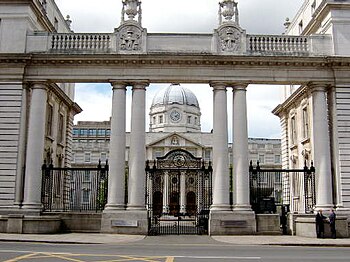Parliament of Southern Ireland
The Parliament of Southern Ireland ( Irish Parlaimint Dheisceart Éireann , Parliament of Southern Ireland ) was created by the Government of Ireland Act in 1920 and originally stems from the Home Rule of 1914, which provided for an independent Irish Parliament. At the same time the Parliament of Northern Ireland was created.
The parliament consisted of two chambers:
- the House of Commons of Southern Ireland ( Teach Teachtaí Dheisceart Éireann ) and
- the House of Lords or Senate of Southern Ireland ( Seanad Dheisceart Éireann ).
Because of the parallel existing but never officially recognized revolutionary Dáil Éireann , parliament never gained great national importance and only had a short term of office of years. In 1922, the Anglo-Irish Treaty created the Irish Free State with its own parliament, the so-called Oireachtas .
The House of Commons
The House of Commons of Southern Ireland was the lower house of the Southern Irish Parliament. In 1921 elections were held for the House of Commons, but in reality they were not. All 128 candidates had no opposing candidates in their constituencies - Sinn Féin won 124 seats, 4 seats went to the Unionists in the constituency of Dublin University. But the 124 members of the Sinn Féin (as well as the Sinn Féin candidates who were elected in the simultaneous election in Northern Ireland) did not see the election for the Southern Irish Parliament, but for the Second Dáil , the second (revolutionary) Irish Parliament whose names they also gathered.
In June 1921, both houses officially “gathered” in the Royal College of Science (now part of the Parliament Building) on Merrion Street for the opening of Parliament under Lord Lieutenant of Ireland Viscount FitzAlan of Derwent . But only the four unionists appeared. They elected Gerald Fitzgibbon as their chairman and adjourned indefinitely.
The House of Commons came back to some importance later, through the Anglo-Irish Treaty . This treaty was confirmed in Ireland by two bodies: in the eyes of the nationalists, the confirmation by the Dáil was decisive, from the point of view of British politics it was the confirmation by the House of Commons of Southern Ireland .
The House of Commons of Southern Ireland was then dissolved and replaced by a new parliament called the Constituent Assembly , Third Dáil or Provisional Parliament - depending on whose political history you are in.
The House of Lords
The Senate of Southern Ireland was the upper house of the Southern Irish Parliament, for which elections were first held in 1921. Like the House of Commons, the House of Lords was boycotted by the Irish nationalists, so that only 15 (out of 61) members gathered. In contrast to the House of Commons, however, two more Senate meetings took place before it was dissolved by the creation of the Irish Free State in 1922.
The Senate was originally supposed to consist of 61 people:
- the Chairman ( Lord Chancellor of Ireland )
- 15 elected southern Irish nobles
- 8 members of the court council
- 2 envoys from the Anglican Church of Ireland
- 2 emissaries of the Catholic Church
- 14 people appointed by the Lord Lieutenant
- 2 persons appointed by the Lord-Lieutenant in coordination with the labor movement
- 17 elected from the county councils
In addition to the Lord-Lieutenant, only 14 senators were elected because the labor movement, the Catholic Church and the county councils (controlled by Sinn Féin) did not cooperate.
Note: This text is based on a translation of the articles w: en: Parliament of Southern Ireland , w: en: House of Commons of Southern Ireland and w: en: Senate of Southern Ireland from the English Wikipedia, version of 28 July 2005.
